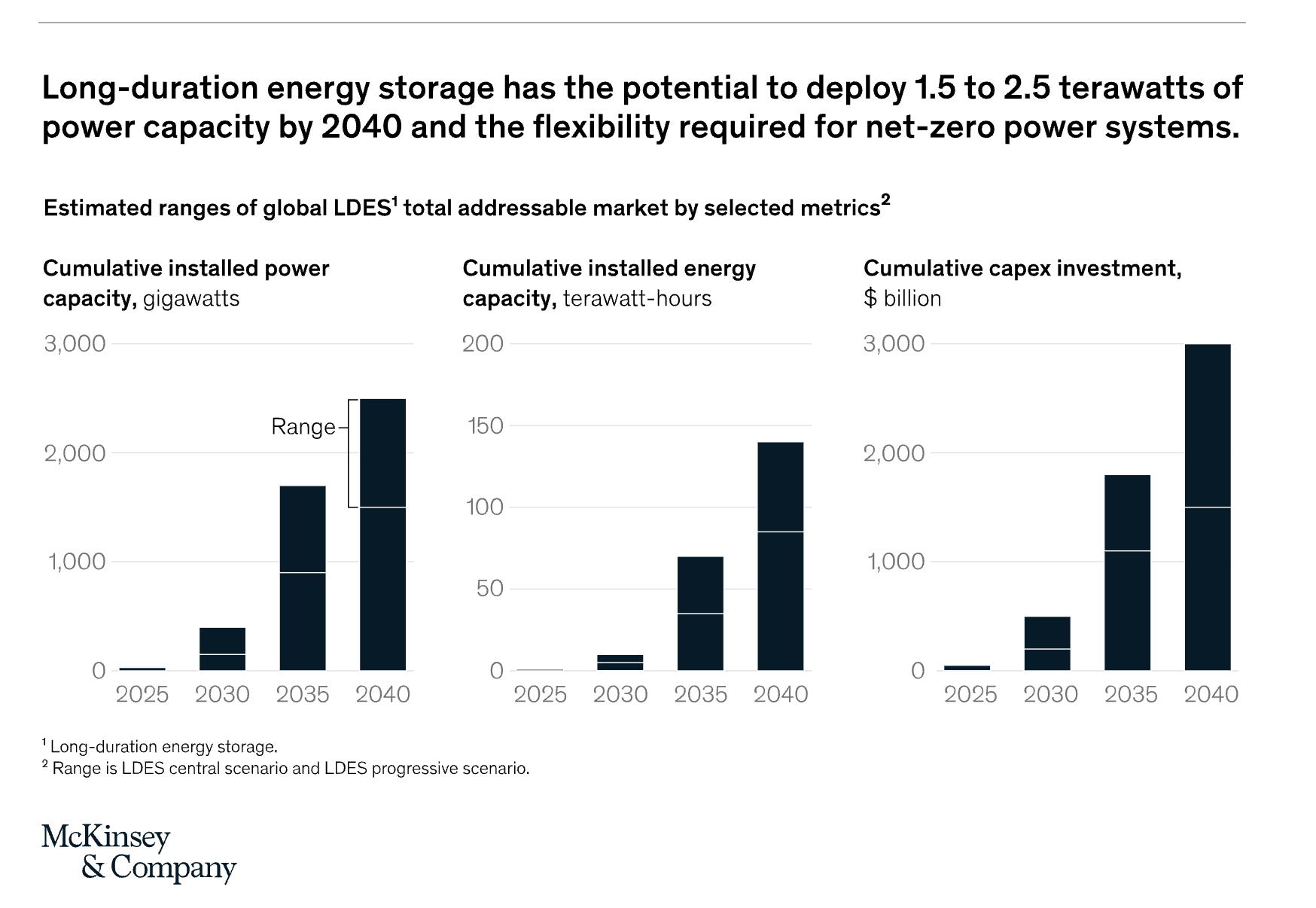
The transition to renewable energy has gained significant momentum in recent years, driven by the urgent need to combat climate change and reduce our reliance on fossil fuels. As solar and wind power become increasingly prevalent, a new challenge has emerged: intermittency. The sun doesn’t always shine, and the wind doesn’t always blow. This unpredictability can strain energy grids and limit the reliability of renewable energy.
This article explores the future of renewable energy storage solutions, the benefits of investing in these technologies, and how entrapeer’s innovation platform can help companies stay ahead in this rapidly evolving field.
The Current Landscape of Renewable Energy Storage
The demand for renewable energy storage solutions has skyrocketed in recent years, driven by the global push for cleaner energy. According to Precedence Research, the global energy storage systems market is expected to grow from USD 210.92 billion in 2021 to USD 435.32 billion by 2030, reflecting a compound annual growth rate (CAGR) of 8.4%. This surge is fueled by increasing industrialization, urbanization, and rising concerns over carbon emissions and air pollution.
However, the path to a sustainable future is not without its challenges. The intermittent nature of renewable energy sources—sunlight and wind are not always available—means that traditional energy storage methods, such as lithium-ion batteries, while effective, are not sufficient to meet future demands.
Other technologies, such as compressed air energy storage (CAES), pumped hydro storage, and thermal energy storage, are emerging as critical players in this space, each offering unique benefits and addressing different aspects of the energy storage challenge.

The Problem with Current Energy Storage Solutions
Despite significant advancements in energy storage technologies, several challenges persist. For instance, lithium-ion batteries, while popular, face issues related to the availability of raw materials and environmental concerns. The extraction of lithium and cobalt, essential components of these batteries, is associated with significant environmental degradation and ethical concerns. Additionally, the disposal of these batteries presents further environmental risks.
Compressed air energy storage (CAES) and pumped hydro storage offer large-scale energy storage solutions but require specific geographical conditions, limiting their deployment to certain regions. Moreover, the high initial costs and long development timelines of these technologies pose significant barriers to their widespread adoption.
Thermal energy storage, while more affordable and longer-lasting, often requires substantial infrastructure and can suffer from efficiency losses.

Meanwhile, the emerging field of hydrogen energy storage, which promises flexibility and high energy density, faces challenges related to storage safety, high costs, and the current lack of a robust infrastructure for hydrogen distribution.
The current landscape of renewable energy storage solutions is therefore a mix of promising technologies, each with its strengths and limitations. The challenge lies in optimizing these solutions to meet the growing demand for reliable, green energy while overcoming the inherent drawbacks of each technology. This is where innovation becomes crucial.
New Innovations in Renewable Energy Storage Solutions
Despite these challenges, the future of renewable energy storage solutions is bright, driven by technological innovations and increasing investments in research and development.
Emerging Trends in Renewable Energy Storage
Several key trends are shaping the future of renewable energy storage solutions:
1. Advancements in Battery Technology
Lithium energy storage solutions due to their high energy density, efficiency, and declining costs. However, the future promises even more advanced battery technologies.

Solid-state batteries, which offer greater energy density and safety, are poised to become a game-changer in the industry. Additionally, redox flow batteries, with their scalability and long-duration storage capabilities, are gaining traction, particularly for grid-scale applications.
2. The Rise of Green Hydrogen
Green hydrogen is emerging as a versatile energy storage solution, capable of storing excess renewable energy and converting it back into electricity or using it as a clean fuel alternative. The ability to store large amounts of energy for long periods makes green hydrogen a crucial component in balancing energy supply and demand, especially as renewable energy penetration increases.
3. Thermal Energy Storage Innovations
Thermal energy storage (TES) systems, which store energy in the form of heat, are becoming increasingly sophisticated. With the ability to store energy from sources like concentrated solar power (CSP) and release it when needed, TES is helping to overcome the intermittency of renewable energy. Innovations in phase change materials (PCMs) and molten salt storage are making TES more efficient and cost-effective.
4. Integration of Compressed Air Energy Storage (CAES)
CAES, which stores energy by compressing air and releasing it to generate electricity, is seeing renewed interest due to its ability to provide large-scale energy storage. As technology advances, CAES is becoming more efficient, with new designs allowing for greater flexibility and lower environmental impact.
5. Grid Modernization and Smart Energy Systems
The future of energy storage is also tied to the modernization of power grids. Smart grids, which use advanced communication and automation technologies, are better equipped to integrate and manage renewable energy storage solutions. These systems can optimize energy distribution, reduce losses, and improve the reliability of renewable energy supply.
The Benefits of Investing in Renewable Energy Storage Solutions
Investing in renewable energy storage solutions offers several significant benefits. First and foremost, it enhances the reliability of renewable energy sources, making them viable alternatives to fossil fuels. By storing excess energy and releasing it during periods of high demand or low production, these systems ensure a stable and continuous power supply.
Additionally, energy storage solutions can reduce overall energy costs. By enabling the use of stored renewable energy during peak demand periods, companies can avoid expensive peak electricity rates. This not only lowers operational costs but also contributes to a more balanced and efficient energy grid.
Furthermore, investing in energy storage solutions positions companies as leaders in sustainability, aligning them with global efforts to reduce carbon emissions and combat climate change. As consumers and investors increasingly prioritize environmental responsibility, companies that lead in renewable energy adoption and innovation will gain a competitive edge.
How Entrapeer is Helping to Shape a Greener Future
At entrapeer, we understand the critical role that renewable energy storage solutions play in the global transition to green energy. Our AI-powered platform leverages cutting-edge technology to provide actionable insights, helping enterprises innovate faster and more effectively. Through our comprehensive market research, use case analysis, and predictive intelligence, we empower companies to make informed decisions about their energy storage investments.
The entrapeer platform stands out by offering a personalized and data-driven approach to innovation. For example, our use case discovery tool allows companies to explore real-world applications of energy storage technologies, helping them identify the most relevant and impactful solutions for their specific needs. By connecting enterprises with the right technologies and startups, we streamline the innovation process, reducing the time and cost associated with deploying new energy storage systems.
Moreover, our platform’s competitor intelligence feature provides a clear view of how leading companies in the renewable energy sector are leveraging energy storage solutions. This allows our users to benchmark their strategies and identify opportunities for differentiation, ensuring they remain competitive in an increasingly crowded market.
The Future is Bright for Renewable Energy Storage
The future of renewable energy storage solutions is incredibly promising. As technology continues to advance, these solutions will play an increasingly vital role in ensuring the reliability and sustainability of our energy systems. For businesses and governments alike, investing in these technologies is not just a smart financial decision—it’s a crucial step towards a greener, more sustainable future.
Entrapeer is here to help companies navigate this complex landscape. By leveraging our AI-powered innovation platform, businesses can stay ahead of the curve, streamline their processes, and make informed decisions that will position them as leaders in the renewable energy storage market.
Don’t miss out on the opportunity to be at the forefront of this energy revolution. Request a demo or sign up for our platform today and see how entrapeer can help you innovate faster, smarter, and more effectively in the world of renewable energy storage solutions.
Sources
- https://www.globenewswire.com/en/news-release/2022/04/06/2417212/0/en/Energy-Storage-Systems-Market-Size-to-Surpass-US-435-32-Bn-by-2030.html#:~:text=According%20to%20Precedence%20Research%2C%20the,8.4%25%20from%202022%20to%202030.&text=The%20global%20energy%20storage%20systems%20market%20size%20was,US%24%20210.92%20billion%20in%202021.
- https://www.precedenceresearch.com/energy-storage-systems-market
FAQs
Renewable energy storage solutions are technologies that store energy generated from renewable sources, such as solar and wind, for use at a later time. These solutions help manage the intermittency of renewable energy, ensuring a stable and reliable power supply even when the sun isn’t shining or the wind isn’t blowing.
Energy storage is crucial because it addresses the intermittency of renewable energy sources. By storing excess energy produced during periods of high generation, it can be used during periods of low generation, ensuring a continuous and reliable supply of electricity.
The best system for storing energy depends on the specific application, scale, and duration of storage needed. For grid-scale applications, pumped hydro storage is often considered the most effective, while lithium-ion batteries are preferred for residential and short-term storage due to their high efficiency and declining costs.
Energy can be stored using lithium-ion batteries, pumped hydro storage, compressed air energy storage (CAES), thermal energy storage (TES), and green hydrogen storage. Each method has its own advantages and is suited to different scales and applications.
Pumped hydro storage is one of the most efficient large-scale energy storage methods, with efficiency rates of up to 80%. For smaller-scale and short-term storage, lithium-ion batteries offer high efficiency, typically around 90-95%.

